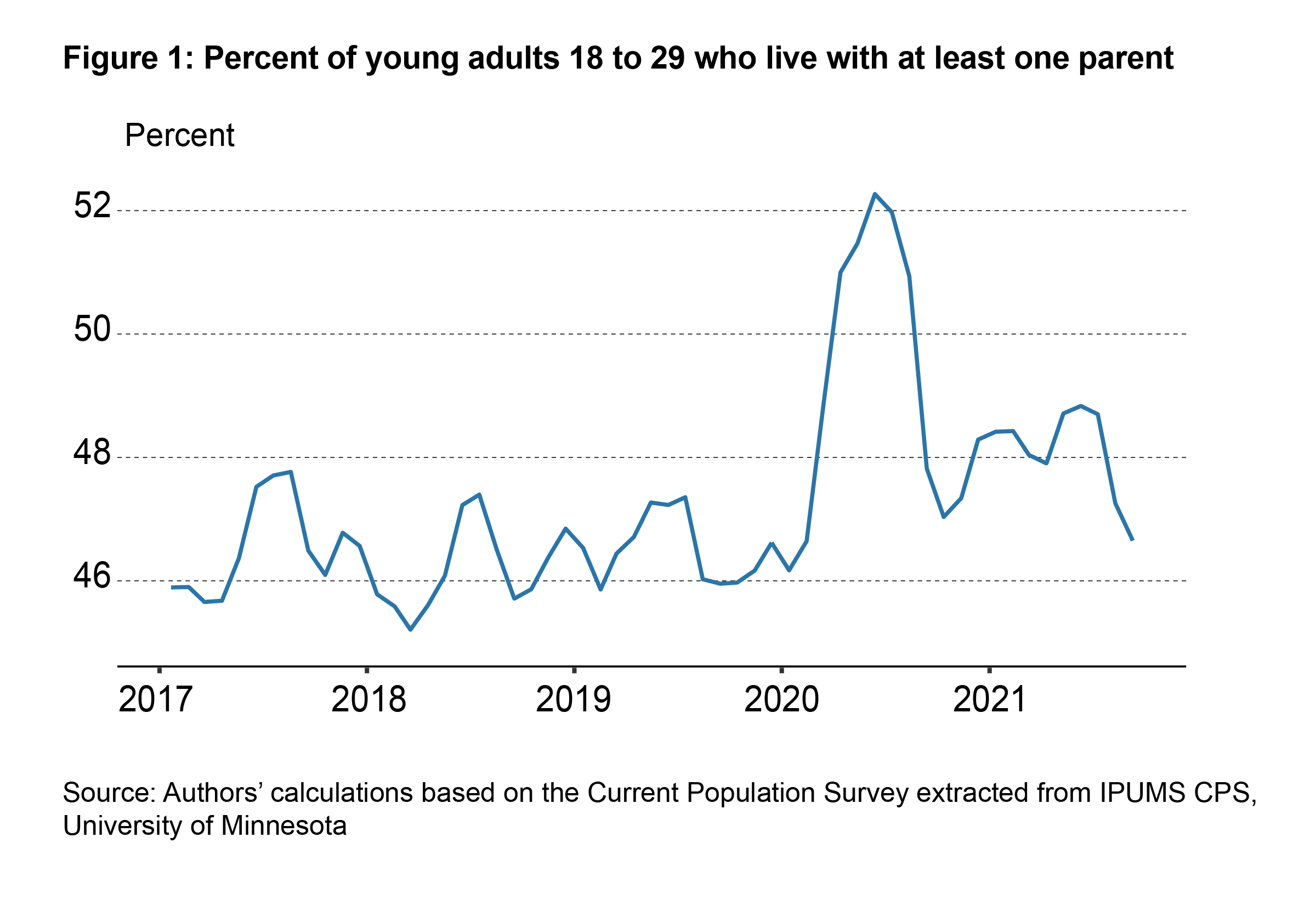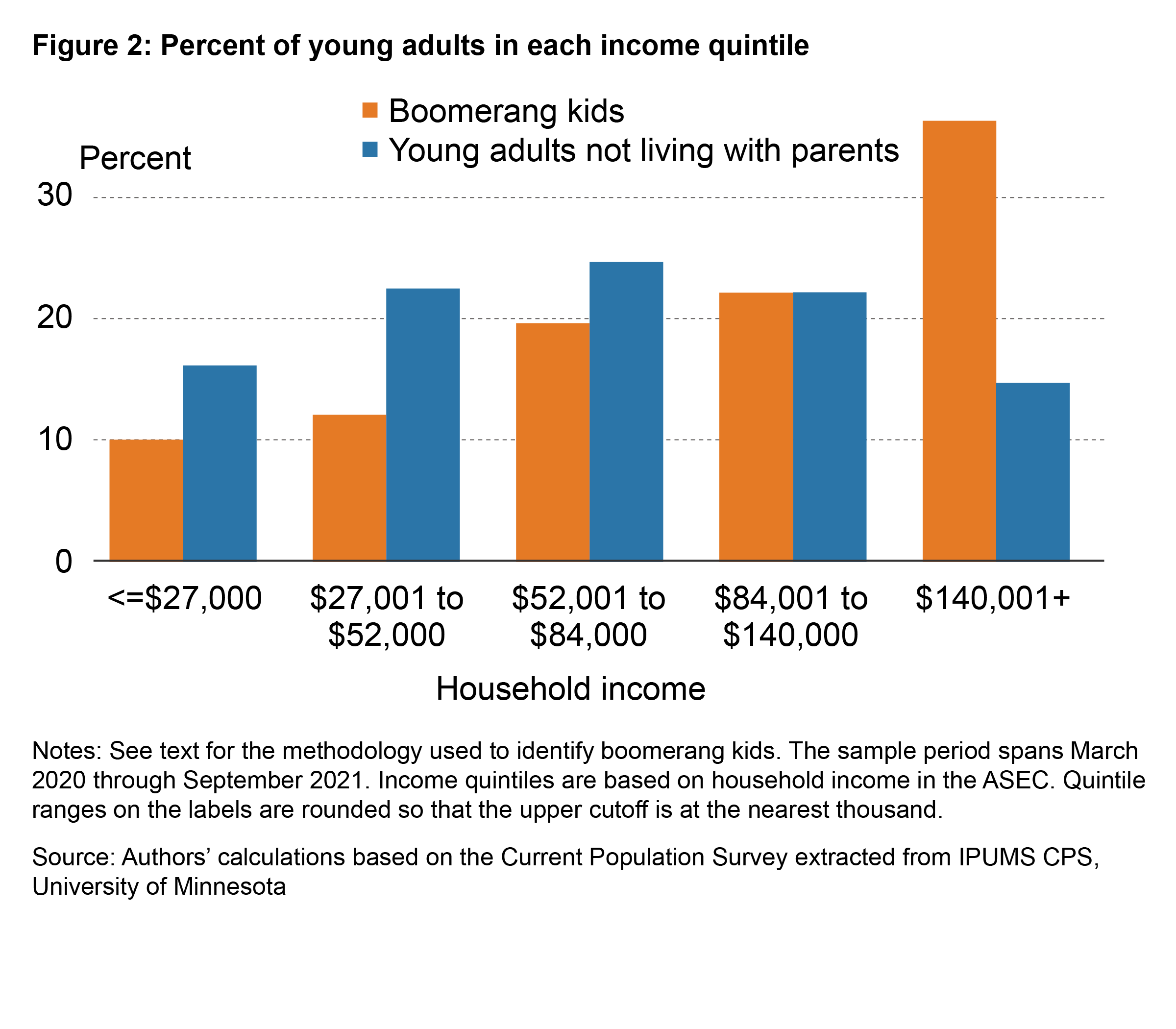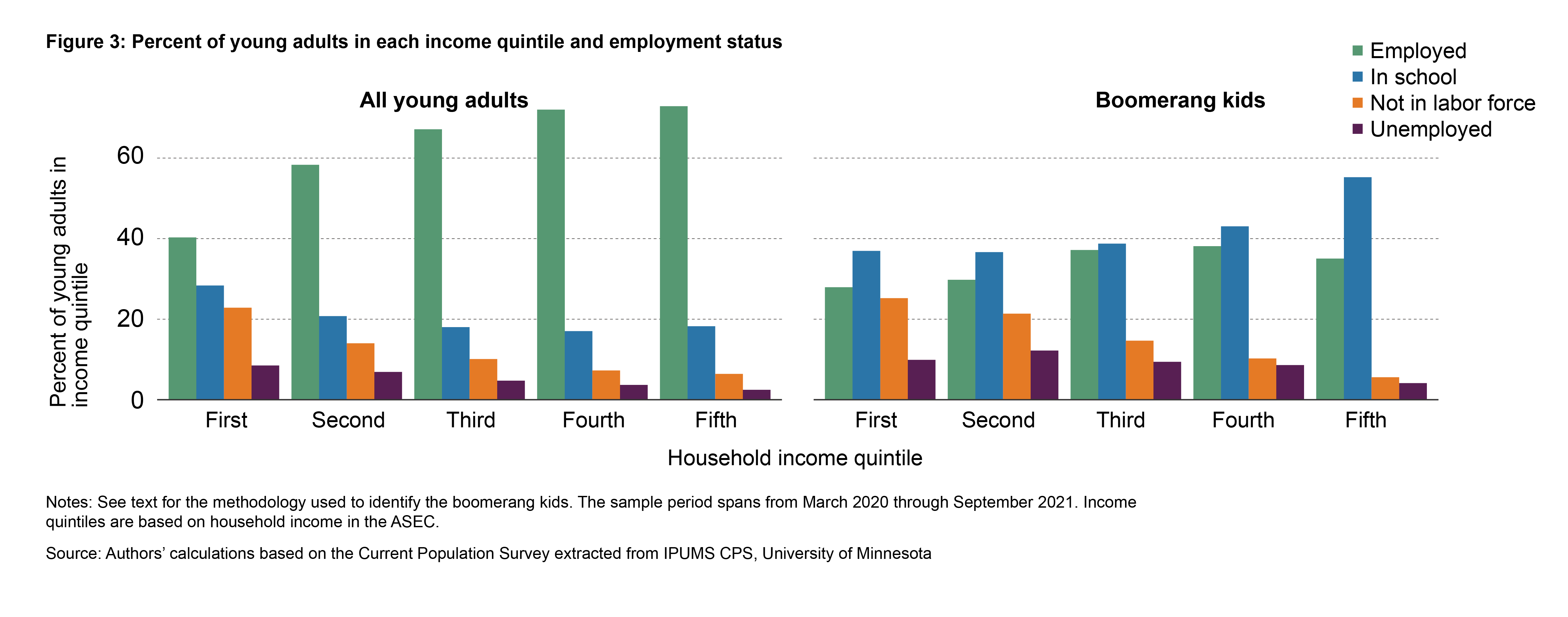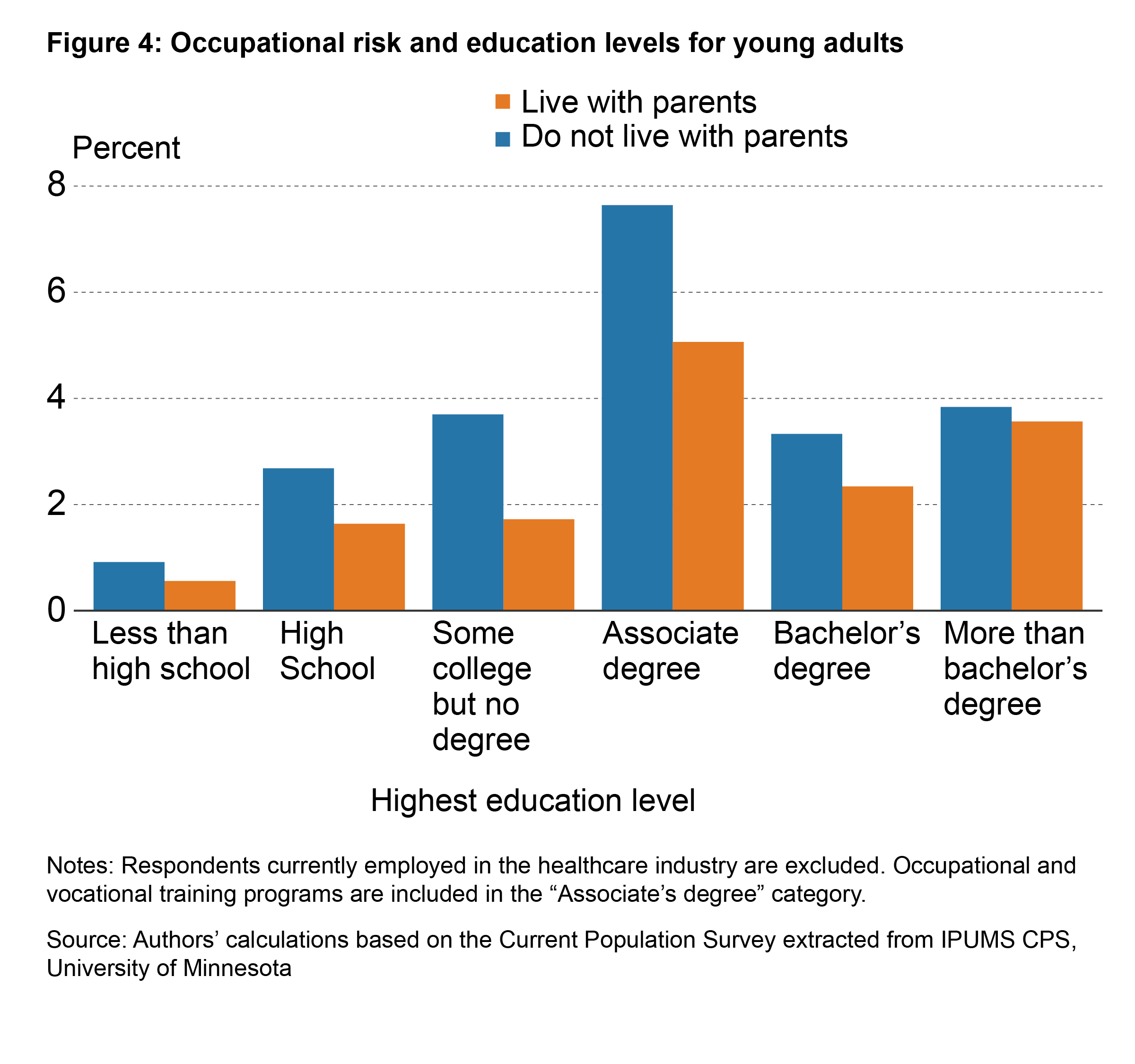Boomerang Kids in the Pandemic: How High-Income Families Are Their Own Safety Net
The views authors express in Economic Commentary are theirs and not necessarily those of the Federal Reserve Bank of Cleveland or the Board of Governors of the Federal Reserve System. The series editor is Tasia Hane. This paper and its data are subject to revision; please visit clevelandfed.org for updates.
The SARS-CoV-2 (COVID-19) pandemic has affected workers and labor markets unequally, shedding light on the many challenges faced by different demographic groups (Gould, Kassa, 2020; Chatterji, Li, 2021). One group that has recently attracted attention in the economic debate is young workers at the start of their careers. This demographic has been shown to face higher unemployment rates and lower job mobility during recessions (Forsythe, 2020), and the pandemic employment shocks could lead to long-term damage to their earnings prospects (Altonji et al., 2016; Schwandt and von Wachter, 2019).
At the onset of the COVID-19 pandemic in the United States in March 2020 there was an increase in young adults living with their parents—what we term the “family home”—as universities closed and millions were laid off, particularly in industries that employed a disproportionate number of young workers (Aaronson and Alba, 2020). Young adults who previously lived outside the family home and then returned are commonly referred to as “boomerang kids.” In this Commentary, we examine what distinguishes boomerang kids from young adults not living in their family home during the pandemic and how these differences translate into choices in the labor market that have broad implications for labor market recovery and equity across income and health.
We find that most boomerang kids come from high-income families who are more likely to be able to financially support their children and enable them to better weather economic shocks. Compared to young adults who are not living with their parents, boomerang kids remain unemployed for longer periods of time and appear to be more selective about the types of jobs they are willing to accept. In particular, boomerang kids are relatively more reactive to the risk of exposure to COVID-19 in a given occupation and are less likely to work in occupations with potentially frequent exposure to COVID-19 or substantial contact with the public. This unequal responsiveness to higher-risk job opportunities leads to fewer boomerang kids’ working contact-intensive jobs than young adults who are not living with their parents. This situation constrains the number of people willing to work in occupations with a relatively high risk of exposure to COVID-19, circumstances which, in turn, could create a shortage of workers in high-risk occupations that previously employed a high concentration of young workers.
Identifying boomerang kids in the pandemic
While we know the pandemic brought millions of young adults back into their parents’ homes, it is hard to distinguish new boomerang kids from young adults who already lived at home before the pandemic unless we observe that the young adult moves into the household during the survey period. We use the Current Population Survey (CPS) to identify young adults who moved into sample households in which we can observe the household prior to the young adult’s arrival. This process ensures that we are measuring only pandemic boomerang kids and not other young adults who were already living in their family home.
Figure 1 notes that the share of 18- to 29-year-olds in the United States living with at least one parent1 rose sharply in March 2020 at the onset of the pandemic and related lockdowns.2 This share reached its peak a few months later in June 2020 before decreasing quickly in September 2020 at or near the start of the academic year, stopping at a level close to the recent prepandemic peak in August 2018. From November 2020 through July 2021, the percent of young adults living with at least one parent stayed at historically high levels until these levels began to decrease in August 2021, returning to prepandemic levels in September 2021. While the series has a seasonal component that coincides with the academic year, the increase in 2020 is notably larger than any previous upticks in the data. The jump of around 6 percentage points of young adults living with at least one parent suggests a strong effect of the most recent crisis on this population.

Boomerang kids: Differences from other young adults
After identifying the boomerang kids in the pandemic, we can proceed to examine the differences between boomerang kids and young adults not living with their parents to pin-down the key aspects that make returning home a possibility for some young adults but not others. We will focus on income distribution, family composition, and attachment to the labor force within this boomerang group. We conduct our analysis for the period spanning March 2020 through September 2021, and to determine household income for young adults, we link our sample data to the Annual Social and Economic Supplement (ASEC) of the CPS.
Income distribution
In Figure 2 we show the percent of boomerang kids and young adults living away from their parents by income quintiles. Thirty-six percent of boomerang kids live in families with household incomes in the highest income quintile, or the top 20 percent of the distribution, with a household income higher than $140,000 per year. Only 10 percent are in the lowest income quintile, with a household income of less than $28,000 per year. In comparison, young adults who do not live with their parents are concentrated in households that have income in the middle quintiles. This distribution suggests that the young adults who chose to move back home largely belong to families with higher levels of income. The observed distribution highlights a potential role of financial insurance provided by families to young adults during the pandemic, as high-income households were likely more able to support an additional person living in the home compared to lower-income families because of both additional costs of adding a person and the space constraints of residences themselves.

Family composition
In general, boomerang kids also differ from young adults in terms of family composition. They are less likely to be married and less likely to have children compared to young adults not living with their parents. Since boomerang kids are less likely to have dependents of their own, they likely face fewer constraints when making the decision to move in with parents since it is easier for a household to absorb one additional person instead of several. Furthermore, a boomerang kid does not have to consider how such a move would directly affect a partner or child. In Table 1, the first column shows that about a quarter of young adults living separately from their parents are married or have children, while the second column shows each of these categories constitutes a small share of boomerang kids.
| Young adults not living with parents | All boomerang kids | Boomerang kids in the lowest income quintile | Boomerang kids in the highest income quintile | |
| Married | 26.4% | 5.0% | 6.3% | 6.8% |
| Have children | 22.9% | 6.6% | 12.6% | 5.4% |
Source: Authors' calculations based on the Current Population Survey extracted from IPUMS CPS, University of Minnesota.
While most boomerang kids are in the upper income quintiles, and the total percent of boomerang kids that have children is low compared to the number of other young adults who have children, there is heterogeneity in family composition among boomerang kids across the income distribution. As we can see in the third and fourth columns of Table 1, low-income boomerang kids are more than twice as likely as high-income boomerang kids to have children. To further investigate these differences in family composition, we look at how boomerang kids who are not in the labor force spend their time while they are not working. Low-income boomerang kids are much more likely to say they are out of the labor force because of house and family responsibilities, with 24 percent of boomerang kids in the lowest income quintile who are out of the labor force reporting spending most of their time taking care of their house or family, compared to only 5 percent of boomerang kids in the highest income quintile.3 This unequal distribution suggests that the reasons boomerang kids move home differ, at least in part, depending on family income level.
Labor market status
To understand the pandemic’s effects on labor market dynamics, we look at the labor force status for boomerang kids compared to that of young adults not living with their parents along with their respective reasons for nonemployment. In Figure 3, we graph boomerang kids and young adults living away from their parents and the percent in each income quintile who are employed, in school, unemployed, or otherwise not in the labor force. Boomerang kids are much less likely to be employed compared to young adults not living with their parents.4 Boomerang kids are also much more likely to be in school, especially those in high-income households.
There are also pronounced differences in labor force status within the boomerang kids’ group by income. Low-income boomerang kids are more likely to be out of the labor force and unemployed compared to high-income boomerang kids. A total of 60 percent of all boomerang kids that entered their parents’ home during the COVID-19 pandemic are not employed at the time they enter, but one third of these initially nonemployed boomerang kids become employed at some point during the duration of our sample. In comparison, 45 percent of the young adults not living with parents and who were nonemployed at the start of the survey became employed at some point in our sample duration.

Boomerang kids and occupational risk in the pandemic
We now move to further examine the potential effects of living with parents by documenting which boomerang kids became employed during the pandemic and in which occupations. Our object of interest is the role of occupational risk during the pandemic.5 Because the number of boomerang kids is a relatively small subset of all young adults, for our occupational analysis we increase the sample from boomerang kids who we observe enter a parent’s home in the CPS monthly data to include all young adults living with at least one parent regardless of whether we observe them enter the household.6
To estimate the overall riskiness of each occupation, we compute an occupational risk index for each occupation in our sample.7 These indices are based on surveys of each occupation that ask about job characteristics and tasks such as proximity to coworkers, interaction with the public, face-to-face interaction, and potential exposure to viruses.
We investigate the relationship between sensitivity to occupational risk and living in the family home and check if nonemployment and reemployment for young adults living with their parents is significantly different than for those who are not. As shown in Table 2, we find that young adults not living with their parents are significantly more likely to find new employment within 26 weeks of becoming nonemployed compared to young adults living with their parents.8 For young adults living with their parents who did become employed after a nonemployment spell, their average duration of nonemployment was more than a month longer than that of young adults not living with their parents. Young adults living at home are less likely to become reemployed and take longer to find new employment even when they do become reemployed. This longer time period suggests that young adults living with their parents may experience less economic pressure to find a job quickly and can wait to find better job matches.
At every income level, employed young adults living in the family home are about half as likely to work in occupations with a high risk of exposure to COVID-19 compared to young adults living without their parents in the same income quintile; further, those who changed occupations from their previous jobs are much less likely to switch into a high-risk occupation.9 The parents of these young adults living at home tend to be older and more at risk of severe complications from COVID-19, so the risk for young adults to take these high-exposure jobs is not just to their own health, but also to their family members’ health. Taken together, these facts suggest that young adults living with their parents are much more responsive to occupational risk and provide stratification to the types of occupations in which these young adults are currently working based on living arrangements.10
| Live with parents | Do not live with parents | Difference | |
| Percent unemployed who become employed within 26 weeks | 57.03% | 66.46% | -9.43*** |
| Average duration of nonemployment (weeks) | 22.71 | 17.94 |
4.77*** |
| Percent of employed young adults working in a high-risk occupation | 7.76% | 14.04% | -6.28%*** |
| Percent of young adults who changed jobs and switched into a high-risk occupation11 | 6.93% | 10.27% | -3.34%*** |
Source: Authors' calculations based on the Current Population Survey extracted from IPUMS CPS, University of Minnesota
The fact that young adults in high-income families are less likely to work in high-risk occupations has broader implications for the labor force during the pandemic. Our analysis suggests that people are aware of occupational risk and take it into consideration in their labor market decisions. This might indicate that workers in high-risk jobs may not have a safer option even if they wanted one. It also means that risk includes more than just exposure to viruses and that potential workers consider interacting with the public and in proximity with coworkers to be risks. This perception matters, especially for the hospitality, leisure, food service, childcare, and retail industries that all have high levels of interacting with the public face to face and tend to hire younger workers, almost half of whom are living in the family home and are especially sensitive to these risks. These circumstances might suggest that current labor shortages in these industries may be due partly to the inherent risk of these occupations during a global pandemic.
Education levels
While we have already shown that young adults living at home are less likely to work in high-risk occupations, we must consider the possibility that differences in education levels between young adults living with and without their parents could affect the occupations they work in and therefore the average occupational risk levels. To separate the effects of education from the effects of living with parents on occupational risk, we show the percent of employed young adults working in a high-risk occupation by education level and living arrangement. In Figure 4 we can observe that young adults living with their parents are less likely to work in a high-risk occupation at every education level when compared to young adults not living with their parents.12 This suggests that the difference in average occupational risk cannot be solely attributed to differences in education levels. Young adults living with parents and who have a degree or certification beyond a high school diploma are more likely to work in high-risk occupations compared to those with lower levels of educations. The high-risk occupations they work in tend to require a specific degree or certification, including those who work as counselors, firefighters, morticians, and flight attendants. These young adults may be less likely to switch occupations since they have invested in obtaining the education or certification required to work in these specific occupations.

Conclusion
Our findings suggest that high-income families have acted as an economic support for their nonemployed young adult children who are without families of their own during the COVID-19 pandemic. This economic support from their families has likely enabled boomerang kids to stay nonemployed for longer periods of time compared to young adults living away from their parents and to be more selective about the jobs they do take. Probably at least in part because they can afford to wait and choose, young adults living with their parents are much less likely to take or keep jobs in occupations with a high risk of COVID-19 exposure. We find that this behavior is consistent across different levels of education. The patterns documented in this article for boomerang kids represent additional evidence of the pandemic’s having unequal economic effects among young workers.
Footnotes
- “Parents” includes biological, step, or adoptive parents but does not include other relatives or caregivers because of restrictions in the data. Return to 1
- See Appendix 1 for a discussion of the impacts on students and comparable results using a sample restricted to older boomerang kids age 24 through 29. Return to 2
- As in reported answers when asked about their major activity in the preceding week. Return to 3
- Of boomerang kids who are employed, 7.1 percent are working remotely because of COVID-19. For employed young adults not living with their parents, 12.5 percent are working remotely because of COVID-19. In May 2020, 22.4 percent of employed boomerang kids were working remotely, compared to 37.7 percent of young adults not living with their parents. Return to 4
- See Birinci and Amburgey (2020) for an account of how employment and hours were affected by the pandemic across different occupations. Return to 5
- A total of 45 percent of young adults living with a parent who were nonemployed at the start of the survey became employed during the survey, a higher rate than the smaller boomerang kids group. Since job-finding behavior for boomerang kids is lower than for the large sample of young adults living with their parents, we consider this larger group as an upper bound on job finding for boomerang kids. Return to 6
- Our calculations are based on the methodology by Beland, Brodeur, and Wright (2021). See Appendix 2 for details on how we construct the occupational risk index. Return to 7
- See Appendix 3 for a detailed description of how we define and obtain nonemployment spells and reemployment flows. Return to 8
- “High risk” is defined as occupations with a risk index of more than one standard deviation above the mean risk level. The cutoff value is 0.7. Return to 9
- Differences in length of nonemployment and average occupational risk existed before the pandemic, but gaps widened during the pandemic period. See Appendix 4 for a replication of Table 2 with a sample prior to the pandemic period. Return to 10
- Occupation switching is measured by changes in a person’s occupation code. There are significant longitudinal mismatches in occupation codes even when a worker has not changed jobs, suggesting that the number of job switchers can potentially be lower than what is shown in our calculations (vom Lehn, Ellsworth, Kroff, 2020). Return to 11
- For this comparison, we exclude healthcare occupations. Healthcare occupations have had fewer nonemployment spells, shorter lengths of nonemployment, and fewer people switching out of the industry compared to other high-risk industries, likely because of the demand and necessity for healthcare workers during the pandemic. This makes differences by living arrangement negligible for these occupations. Return to 12
References
- Aaronson, Stephanie, and Francisca Alba. 2020. “Unemployment among Young Workers during COVID-19.” Brookings (blog). September 10, 2020. https://www.brookings.edu/research/unemployment-among-youngworkers-during-covid-19/.
- Altonji, Joseph G., Lisa B. Kahn, and Jamin D. Speer. 2016. “Cashier or Consultant? Entry Labor Market Conditions, Field of Study, and Career Success.” Journal of Labor Economics 34 (S1): S361–401. https://doi.org/10.1086/682938.
- Béland, Louis-Philippe, Abel Brodeur, and Taylor Wright. 2020. “The Short-Term Economic Consequences of COVID-19: Exposure to Disease, Remote Work and Government Response.” 13159. IZA Discussion Papers. Institute of Labor Economics (IZA). https://ideas.repec.org/p/iza/izadps/dp13159.html.
- Birinci, Serdar, and Aaron Amburgey. 2020. “How Has the COVID-19 Recession Affected U.S. Labor across Occupations and Industries?” Federal Reserve Bank of St. Louis. On the Economy (blog). November 8, 2020. https://www.stlouisfed.org/on-the-economy/2020/november/covid19-recession-affected-labor-occupations-industries.
- Chatterji, Pinka, and Yue Li. 2021. “Recovery from the COVID-19 Recession: Uneven Effects among Young Workers?” Working paper 29307. National Bureau of Economic Research. https://doi.org/10.3386/w29307.
- Flood, Sarah, Miriam King, Renae Rodgers, Steven Ruggles, J. Robert Warren, and Michael Westberry. 2021. “Integrated Public Use Microdata Series, Current Population Survey: Version 9.0.” Minneapolis, MN: IPUMS. https://doi.org/10.18128/D030.V9.0.
- Forsythe, Elizabeth C. Conditionally Accepted. “Why Don’t Firms Hire Young Workers During Recessions?” Economic Journal.
- Gould, Elise, and Melat Kassa. 2020. “Young Workers Hit Hard by the COVID-19 Economy: Workers Ages 16–24 Face High Unemployment and an Uncertain Future.” Report 203139. Economic Policy Institute. https://epi.org/203139.
- Lehn, Christian vom, Cache Ellsworth, and Zachary Kroff. Conditionally Accepted. “Reconciling Occupational Mobility in the Current Population Survey.” Journal of Labor Economics.
- Schwandt, Hannes, and Till von Wachter. 2019. “Unlucky Cohorts: Estimating the Long-Term Effects of Entering the Labor Market in a Recession in Large Cross-Sectional Data Sets.” Journal of Labor Economics 37 (S1): S161–98. https://doi.org/10.1086/701046.
Suggested Citation
Widra, Rachel, and André Victor D. Luduvice. 2021. “Boomerang Kids in the Pandemic: How High-Income Families Are Their Own Safety Net.” Federal Reserve Bank of Cleveland, Economic Commentary 2021-21. https://doi.org/10.26509/frbc-ec-202121
This work by Federal Reserve Bank of Cleveland is licensed under Creative Commons Attribution-NonCommercial 4.0 International
- Share





